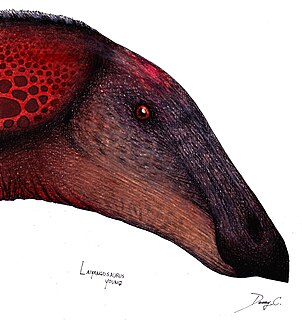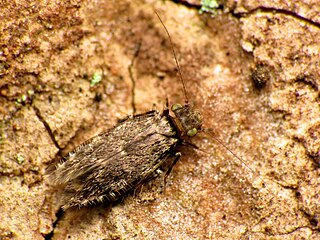
Mamenchisaurus is a genus of sauropod dinosaur known for their remarkably long necks which made up nearly half the total body length. Numerous species have been assigned to the genus; however, many of these might be questionable. Fossils have been found in the Sichuan Basin and Yannan Province in China. Several species are from the Upper Shaximiao Formation whose geologic age is uncertain. However, evidence suggests that this be no earlier than the Oxfordian stage of the Late Jurassic. M. sinocanadorum dates to the Oxfordian stage and M.anyuensis to the Aptian stage of the Early Cretaceous ~114.4 mya. Most species were medium to large size sauropods 15 to 26 meters in length. Two as yet undescribed cervical vertebrae, which might belong to M. sinocanadorum, suggest one of the largest dinosaurs known; estimated at 35 metres (115 ft) in length and possibly weighed 60 and 80 tonnes.

The common vampire bat is a small, leaf-nosed bat native to Latin America. It is one of three extant species of vampire bat, the other two being the hairy-legged and the white-winged vampire bats. The common vampire bat practices hematophagy, mainly feeding on the blood of livestock. The bat usually approaches its prey at night while they are sleeping. It then uses its razor-sharp teeth to cut open the skin of its hosts and lap up their blood with its long tongue.

The white-winged vampire bat, a species of vampire bat, is the only member of the genus Diaemus. They are found from Mexico to northern Argentina and are present on the islands of Trinidad and Margarita.

Sinornithoides is a genus of troodontid theropod dinosaurs containing the single species Sinornithoides youngi. S. youngi lived during the Early Cretaceous. It measured approximately one meter long (3.3 ft). It lived in Inner Mongolia, China, and probably ate invertebrates and other small prey. They live in what is now Mongolia, which was part of Laurasia.
Yimenosaurus is an extinct genus of plateosaurid sauropodomorph dinosaur that lived in China in the Early Jurassic. The genus was first named in 1990 by Ziqi Bai, Jie Yang and Guohui Wang, along with its type and only species, Yimenosaurus youngi. The species name honours renowned Chinese paleontologist Yang Zhongjian, the father of Chinese paleontology, known as C.C. Young in English. Known material includes the holotype, an almost complete skull and mandible, as well as incomplete cervical and dorsal vertebrae, a mostly complete sacrum, an ilium, ischia, partial ribs and complete femur, and a paratype, a well-preserved postcrania with a fragmentary skull. In 2010 Paul estimated its length at 9 metres (30 ft) and its weight at 2 tonnes.

Bishanopliosaurus is a genus of plesiosaur. The type species is B. youngi, based on remains found in the Ziliujing Formation of China.
Ptychatractus is a genus of sea snails, marine gastropod mollusks in the family Ptychatractidae.
Beishanodon is an extinct genus of eucynodonts from Lower Triassic of China. The type and only species is Beishanodon youngi.
Ordosiodon is an extinct genus of therocephalian therapsids from the Early Triassic of China. It includes two species, O. lincheyuensis and O. youngi.

Laiyangosaurus is a genus of saurolophine hadrosaurid from the Late Cretaceous of China. It is known from one species, L.youngi, found in the Laiyang Basin within the province of Shandong.

Echmepteryx is a genus of scaly-winged barklice in the family Lepidopsocidae. There are more than 80 described species in Echmepteryx.
Kunzeana is a genus of leafhoppers in the family Cicadellidae. There are more than 30 described species in Kunzeana.
Echmepteryx intermedia is a species of scaly-winged barklouse in the family Lepidopsocidae. It is found in the Caribbean Sea, Central America, and North America.
Hydroporus signatus is a species of predaceous diving beetle in the family Dytiscidae. It is found in North America.
Berosus youngi is a species of water scavenger beetle in the family Hydrophilidae. It is found in North America.

Attidops youngi is a species of jumping spider in the family Salticidae. It is found in the United States and Canada.
Phloeosinus scopulorum is a species of crenulate bark beetle in the family Curculionidae. It is found in North America.

Phileurus is a genus of rhinoceros beetles in the family Scarabaeidae. There are more than 20 described species in Phileurus.
Peltotrupes is a genus of earth-boring scarab beetles in the family Geotrupidae. There are at least two described species in Peltotrupes.
Peltotrupes youngi, known generally as Young's deepdigger scarab, is a species of earth-boring scarab beetle in the family Geotrupidae. Other common names include the ocala burrowing scarab and ocala deepdigger scarab beetle. It is found in North America.








